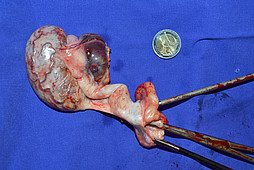Abdominal Cryptorchid (Rig)
At the end of April 2019, a 5-year-old horse which outwardly appeared to be a gelding was presented at the hospital. A blood test from the referring veterinary surgeon had revealed increased testosterone levels and the horse showed stallion-like behaviour. It was soon suspected that the horse must be a rig after unilateral castration.
A horse is called a cryptorchid when one or both testes are not externally visible or palpable. These testes can be located in the inguinal canal (inguinally) or in the abdomen (abdominally). It is a commonly occurring developmental disorder in horses. Normally, both testes descend into the scrotum shortly after birth. In cases of cryptorchism, this does not happen. Horses suffering from cryptorchism often show aggressive behaviour, are difficult to handle and display “stallion-like behaviour” in the presence of mares.
In this case, both palpation of the scrotum and ultrasonographic examination showed no testicular tissue in the inguinal area. Subsequent rectal examination did not reveal the whereabouts of the testicle either. However, upon close inspection the left castration scar showed irregularities. Upon the owner’s request, diagnostic laparoscopy (minimally invasive and without general anaesthesia) was performed on the standing horse.
With the laparoscope (video endoscope), our surgeon Dr. David Lichtenberg was able to locate the “hidden” testicle in the left half of the abdomen and managed to take hold of it with the aid of special, extremely long grasping forceps. Next, he detached the abdominal testicle and the appendix testis with the aid of the vessel sealing system LigaSure. Thus, the testicle was now free in the abdomen, only fixed by the surgical forceps. Through a small incision in the lateral abdominal wall, the testicle could be removed from the abdomen. The use of this technology (LigaSure) allows the surgeon to dissect tissue inside the abdomen and to detach organs such as testicles or ovaries. The blood vessels are ligated using fusion technology without the use of foreign material (sutures, staples). A further advantage of laparoscopic standing castration is the good overview and the associated quick detection of secondary haemorrhage which can then immediately be staunched. Operation time amounts from one hour to one and a half hours and general anaesthesia can be avoided. Skin incisions are usually very small and thus not very painful for the horse.
Within a few days the horse could be discharged from the hospital.
At Pferdeklinik Hochmoor, this procedure is the method of choice for many other surgical procedures as well. Among others, ovarian tumours and cases of chronic colic are operated in this way.
![[Translate to English:] Kleintiermedizin Hochmoor [Translate to English:] Kleintiermedizin Hochmoor](/kv/_processed_/7/e/csm_Kleintiermedizin-Hochmoor_c796a9e531.jpg)
![[Translate to English:] Klinik für Pferde [Translate to English:] Klinik für Pferde](/kv/_processed_/0/d/csm_pferdeklinik-01_c18cc541af.jpg)
![[Translate to English:] Allgemeine Untersuchung Kleintier [Translate to English:] Allgemeine Untersuchung Kleintier](/kv/_processed_/1/5/csm_allgemeine-Untersuchung-Kleintier_cdba7ebb98.jpg)
![[Translate to English:] Lahmheitsuntersuchung Pferdeklinik Hochmoor [Translate to English:] Lahmheitsuntersuchung Pferdeklinik Hochmoor](/kv/_processed_/2/e/csm_Lahmheitsuntersuchung-Pferdeklinik-Hochmoor_8e9ec18025.jpg)

![[Translate to English:] Tiermedizin Hochmoor CT Hund [Translate to English:] Tiermedizin Hochmoor CT Hund](/kv/_processed_/6/4/csm_Kleintiermedizin-3_56aa5d056b.jpg)
![[Translate to English:] Tiermedizin Hochmoor Kleintiermedizin [Translate to English:] Tiermedizin Hochmoor Kleintiermedizin](/kv/_processed_/d/e/csm_Tiermedizin-Hochmoor-Kleintiere_5f8df77a2f.jpg)
![[Translate to English:] Pferdemedizin Hochmoor [Translate to English:] Pferdemedizin Hochmoor](/kv/_processed_/5/6/csm_Pferdemedizin-Hochmoor_2a06563c44.jpg)
![[Translate to English:] Operationswunde direkt nach dem Eingriff Wound immediately after laparoscopic surgery](/kv/_processed_/6/7/csm_re_DSC_1111-1_07d7d5d4a1.jpg)
![[Translate to English:] Operationswunde direkt nach dem Eingriff 2 Wound immediately after surgery](/kv/_processed_/8/7/csm_re_DSC_1112-1_9b6bfe6a78.jpg)
